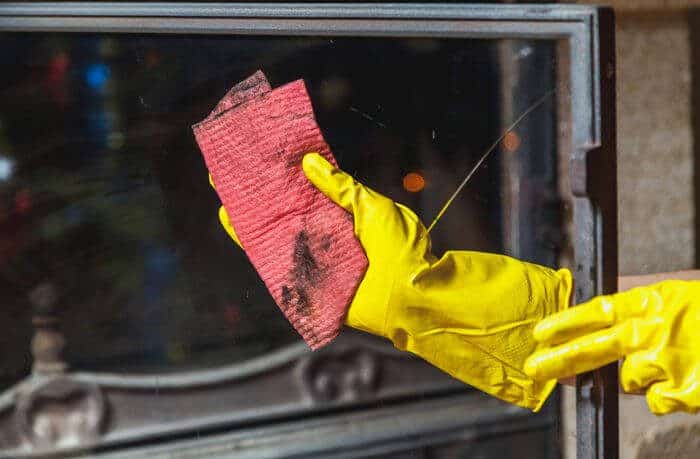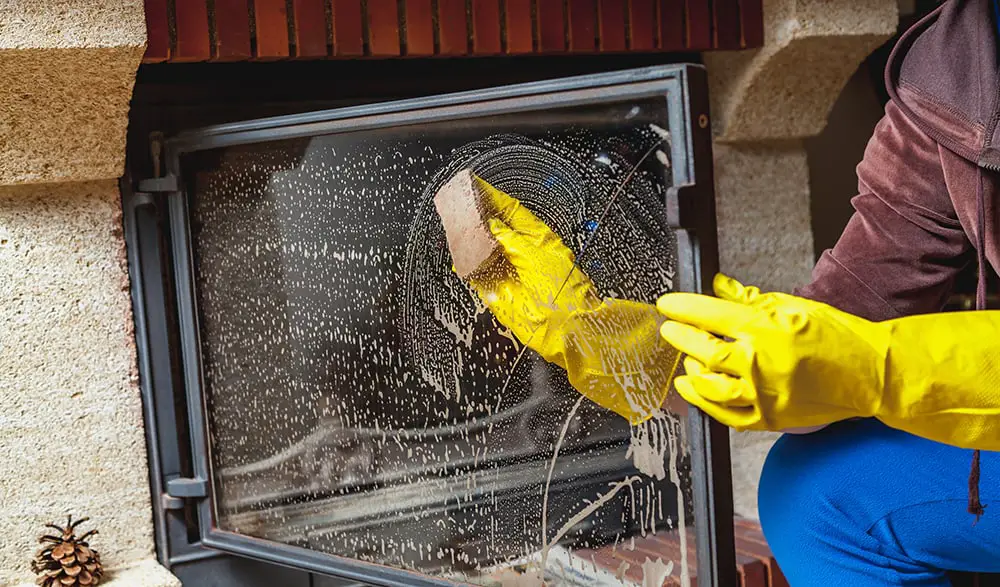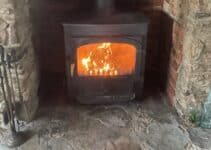Nothing can be as relaxing and comfortable as snuggling up by a crackling fire on a cold winter evening.
However, as time progresses and the winter chill continues to intensify, you will notice that the efficiency and aesthetic appeal of the wood burning stove located in your living room declines.
To resolve this issue and keep the stove operating at its peak, you have to go out of your way and clean out the creosote and ash accumulation in the unit, something which you might not be too accustomed to.
There is no need to worry though as the issue of cleaning a wood burning stove is a small one that can be tackled with little to no skill.
In this simple guide, we explain all you need to know about how to clean a wood burning stove to keep it operating at its best for better efficiency and performance as well as looks.
Do You Have To Clean A Wood Burning Stove?
Yes, you do have to clean a wood burning stove.
You need to do this for safety as well as looks. It is essential that you clean your wood burning stove once in a while to prevent chimney fires, make your room look less messy and get less smoky when a fire is going, and generally increase the efficiency of the stove and lengthen its lifespan.

Stoves like everything else need a little TLC!
Moreover, cleaning your wood burning stove will prevent any soot or dirt from building up in the room and stop a sooty smell from permeating into the upholstery of any furniture in the room or the curtains and carpet.
How Often Should You Clean A Wood Burning Stove?
Although there is no time limit on how long you should wait before cleaning your wood burning stove, it is generally recommended that you clean it at least once every month or whenever you notice it is dirty.
During periods of heavy use, say in the heart of winter, you may need to increase the frequency of cleaning your wood burning stove to once every two weeks, or even once a week.
If you use your wood stove as a primary heating source every day, you would naturally need to scoop out the ash daily to allow the stove to continue functioning effectively.
And as soot and other debris will be building up fast in the stove, you will need to carry out a thorough cleaning process once every one or two weeks.
On the other hand, if you rarely use the wood burning stove in your home, you would naturally need to clean it less often, as the creosote and ash buildup would be at a much slower rate.
Cleaning out the ash in the firebox would ensure better airflow in the firebox, resulting in a better, and hotter flame. Once the creosote buildup in the stove has exceeded 1/8”, you should start the cleaning process to minimise the risk of fire hazards.
To determine whether it is time to clean your stovepipe, gently knock on the flue when the stove is not in use. If you can hear debris falling, then the stovepipe is dirty and it is ripe for the next cleaning operation.
Safety Tips When Cleaning A Wood Burning Stove
Cleaning a wood burning stove can be a risky business, especially if not handled properly. As such, consider the following safety tips before embarking on the journey to clean your wood burning stove:
- Only clean the stove when it has entirely cooled down. This is particularly the case as a hot stove can scald you.
- Only clean the stove when there are no embers as embers buried in the ash can remain hot even long after the fire in the stove has gone out.
- Always put the ash from the wood burning stove into a metal container and not a plastic one.
- Always dress appropriately and wear protective gloves when scooping out ash from a wood burning stove as the process can be messy.
- Never clean the stovepipe on your roof alone, always ensure there is another person around for safety reasons.
How Do You Clean A Wood Burning Stove?
If you have never cleaned your wood stove before, you are probably racking your brains right now wondering where to start the cleaning process.
However, you need not worry as we have broken down the steps you need to follow when cleaning your wood burning stove.
Generally speaking, you should start by cleaning the inside of the stove, followed by the outside.
Cleaning the stovepipe which is usually located on the roof of your house needs to be done much less often but it will make a mess inside the stove, so don’t clean inside and outside the stove just before you do it as you will only have to do it again.

How Do You Clean The Inside Of A Wood Burning Stove?
Here is a simple step by step guide on how to clean the inside of your wood burning stove:
Step 1 – Allow the Stove to Become Cold
First, let the fire go out and allow the stove to cool down completely. This is because handling a hot stove can pose serious safety risks such as burns. It is therefore essential to ensure that there are no burning embers in the stove before starting the cleanup process.
Step 2 – Get Some Protective Gloves and Put Down Newspaper
Wear some protective gloves and place old newspapers on the ground in front of the stove. The newspapers will help trap any ashes that fall off the shovel during the scooping process, thereby making the cleanup process much easier.
Step 3 – Open the Air Dampener
Open the air dampener located in front of your wood burning stove to allow any ash stuck in the stove to fall into the firebox. If the stove is still warm, opening the air dampener using your bare hands is not advisable, and you should therefore use a piece of hooked metal to pull it out.
Step 4 – Scoop Out All The Ash
Open the glass door at the front of your wood burning stove, and using a metal ash shovel, scoop all the ashes out of the firebox.
Ensure that you thoroughly clean out the ashes in the stove as it will be easier to start your next fire on a clean stove. You can even spritz some water on the ash to make it easier for scooping.
Step 5 – Dump the Ash into a Metal Container
Dump the ash into a metal ash can, and after you are done scooping out the ashes from the firebox, place the lid on the ash can, and let it rest on a non-flammable surface for at least 24 hours before placing the ashes in a bin.
Allowing the ash to stand for 24 hours before disposing of it will provide sufficient time for any live coals to burn into ash.
If you do not currently have one I recommend this:
Step 6 – Dispose of the Newspaper
Once you have moved away the ashes, you can remove the old newspapers that you initially spread on the carpet and dispose of them as they contain traces of ash.
Step 7 – Dispose of the Ashes When They’re Cold
Dispose of the ashes when it isn’t windy outside as dormant embers may reignite in a strong wind, or the ashes may be blown away, causing a huge mess.
How Do You Clean The Door Of Your Wood Burning Stove?
With the inside of your wood burning stove now clean, it is time to focus on the glass door of your wood burning stove.
The glass door enables you to clearly see the flickering flames and burning embers inside the stove, making it one of the best features of a wood burning stove.
However, with time, the glass becomes blackened by soot, making it impossible to enjoy the full experience of a wood burning stove.
As such, it is important that you clean this glass door once in a while if you want to continue enjoying the beauty of a crackling fire.
Before starting the cleanup though, it is important to ensure that the glass is totally cool. This is because using cold cleaning liquids or products on the glass door will weaken or shatter it.
Some of the methods you can use to clean the glass on your stove’s door include:
- Diluting some ammonia in water and spraying it on the glass. Next, wipe the glass using a piece of cloth until the window is clean.
- Purchasing commercial cleaning products and adhering to the instructions on cleaning a glass surface using the product.
- Dipping some old newspaper or a piece of cloth in water and any residual ash left in the wood burner and using it to wipe the glass door.
How Do You Clean The Outside Of A Wood Burning Stove?
The exteriors of most wood burning stoves are made of cast iron and have a high strength and heat resistance.
However, despite its durability and strength, the cast iron exterior of your wood burning stove isn’t immune to grease like WD40, grime, or even rust. As such, you will regularly have to clean the outside of your stove to help it maintain an attractive appearance.
Cleaning the exterior of your stove is usually an easy task that can be handled using a vacuum cleaner and a soft brush attachment to remove traces of dust and ash on the stove.
Alternatively, you can use a lint-free dry cloth to wipe it clean, but be careful never to use a damp cloth as it can lead to rust buildup on the surface of your stove.
If the outside of the stove is already rusted, you can easily remove the rust patches by rubbing it using a piece of medium grade steel wool until it vanishes.
How Do You Clean The Stovepipe Of A Wood Burning Stove?
Most people are wary of heights and don’t mind hiring a professional cleaning company to clean the stovepipe of their wood burning stove.
However, it isn’t that much of a complex job and although it will require some physical exertion, and as long as you are relatively fit and not clumsy, you can comfortably handle the task on your own.
Just be sure someone is holding the ladder for you.
Here are the steps you should follow to keep your stovepipe sparkling clean:
Step 1 – Open The Flue
Start by fully opening the flue and shutting the door to your wood stove.
Step 2 – Get Up Onto The Roof
Using a ladder, climb up to the roof of your house and remove the cap on your stove’s chimney.
Step 3 – Tie Your Brush to the Base of the Stove Pipe
To prevent the chimney brush from falling down while cleaning, consider tying its handle to the base of the stove pipe using a rope.
When attached to the base of the stove pipe, you can easily pull up the brush if it accidentally slips out of your hand.
Step 4 – Plunge Up and Down
Insert the chimney brush into the chimney and twist it as you plunge it up and down. This will ensure all the dirt accumulation in the cleaned area is completely removed.
Put some elbow grease into the chimney to soften the creosote and soot buildup inside it.
Step 6 – Go Deeper
As you continue cleaning downwards, screw the next extension rod onto the end of the brush to allow it to reach deeper into the flue.
Step 7 – Go All The Way Down
Continue adding extension rods and carrying out the scrubbing, twisting, and plunging until you run into the flue located inside your home.
Step 8 – You are Done
Wrap up the process by removing the brush and screwing back the chimney gap. Next, proceed to clean the inside of your wood stove to remove the huge mess made from cleaning the stovepipe.
Tips On How To Maintain Your Wood Burning Stove
To enjoy the most out of your wood burning stove, you have to invest in its maintenance alongside the regular cleaning.
Some of the important maintenance tasks you will need to do to prolong the life and increase the performance of your wood burning stove include:
- During the cleaning process, inspect the door and flue seals on your wood burning stove as they tend to flatten and lose their shape with time, resulting in low stove efficiency and leaking fumes. To determine whether your stove’s seal is still intact, set a small fire in the stove with all the doors and air intakes closed. Next, move a lit candle around the closed door, and if the flame is drawn towards it, then your stove has a poor rope seal that needs replacing.
- Health check your wood burning stove once in a while by cleaning out the firebox and inspecting the inside of the stove for any broken firebricks.
- After a rainy day, consider leaving the door and air inlets of your wood burning stove wide ajar to encourage air to flow through the chimney, thereby keeping it dry.
- Reseal the slate hearth of your wood burning stove to enhance its colour and ease the cleaning process.
- A fresh coat of paint is always welcome. If your wood burning stove is looking somewhat tired and the initial heat resistant paint on the stove has worn off, do not hesitate to take out your paint can and do it justice. However, before commencing the painting, ensure you mask off the glass door window and handles using old magazines. Do note that the paint can create a chemical-type smell for a few burns. Some people when painting their wood burners will therefore have a few burns when the window is open or they are not there to have to put up with the pong.
Conclusion
It is not all that difficult to look after a wood burning stove. Make its cleaning and maintenance part of your regular routine. Look after your wood burner and it will look after you for many years to come.






